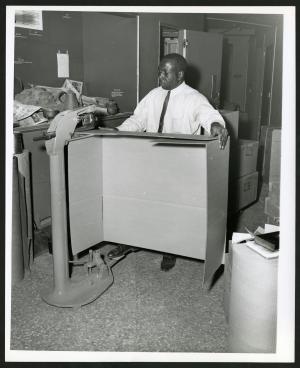In May of 1954, Barry B. Hampton, a scientific aide in the
United States National Museum's Division of Reptiles and Amphibians, retired after 42 years at the Smithsonian. His journey from mail clerk to scientific aide was not an easy one, but he enjoyed his work and made significant contributions to the collection and the museum. At his retirement party, attended by 200 people, he recalled how fascinated he was by the work he observed as he delivered mail to the various museum departments.
He had joined the museum’s staff in 1912 as a mail clerk, but in 1926 was able to move to the Division of Reptiles and Bachtrachians (later Reptiles) assisting the curator, Doris M. Cochran. However, he was classified as a laborer, not a museum aide, as was typical for African American employees of the era. His 1926 annual salary was $1020, rose to $1080 in 1928, and to $1380 in 1929, but then the stock market crashed, the Great Depression ensued, and like most Smithsonian employees, his salary remained at $1380 until 1940 when it increased by $60 a year to $1440.

But Hampton (pictured with Cochran, left) enjoyed his work and had a great working relationship with Cochran, the only two employees in the Division. Hampton was in charge of preservation of the collection, checking every specimen annually, refilling the storage jars with preservative, carefully checking in each new specimen, preparing skins, labeling them, and putting them in the collection. It could get lively--one day he opened an incoming package to find himself face-to-face with a very unhappy live Oklahoma rattlesnake. He managed to stay out of striking distance but later recalled it was his “closest brush with danger.” He carefully packed specimens for shipment to experts for research and exchange, prepared specimens for exhibits, and assisted visiting researchers who were using the collection. He was a self-motivated employee who loved his work, although he was often frustrated at the lack of needed supplies, such as shelving, bottles, and formalin.
 By the late 1940s, he wanted a promotion from laborer to a museum aide or SP (sub-professonal) position, but it proved difficult to secure. Cochran did her best to justify it, based on the quality of his work and a comparison with job titles of similar employees. Memos to her supervisors make clear the high esteem in which she held him and her belief that he deserved to be promoted. But this was the 1940s, and, interestingly, she made her argument by comparing his work with that of other African American employees in the museum. She noted that George F. McBryde (pictured above) in the Ethnology Division performed very similar duties, but he was in the SP series.
By the late 1940s, he wanted a promotion from laborer to a museum aide or SP (sub-professonal) position, but it proved difficult to secure. Cochran did her best to justify it, based on the quality of his work and a comparison with job titles of similar employees. Memos to her supervisors make clear the high esteem in which she held him and her belief that he deserved to be promoted. But this was the 1940s, and, interestingly, she made her argument by comparing his work with that of other African American employees in the museum. She noted that George F. McBryde (pictured above) in the Ethnology Division performed very similar duties, but he was in the SP series.

Cochran also compared Hampton’s work with that of Harry C. Harden (pictured kneeling, right), a taxidermist and exhibits preparator, who was at the SP-4 level. She even argued that Hampton’s work was more demanding. She noted that if Hampton was not promoted, he intended to file an appeal, so it would be better to respond to this before formal proceedings. McBryde and Harden were newer hires which may explain why they were not confined to the laborer job series. There is no evidence that a promotion went through, so in November of 1949, Hampton did file an “Appeal from Classification Allocation.” His job title was subsequently changed to “scientific aide,” so Hampton’s insistence on recognition of the level of work he performed was effective. This scientific aide retired from the museum in 1954, devoting his time to serving as Grand Master of the Prince Hall Lodge of the Masons and deacon in the Nineteenth Street Baptist Church, until his death in 1961.
Related Resources


 By the late 1940s, he wanted a promotion from laborer to a museum aide or SP (sub-professonal) position, but it proved difficult to secure. Cochran did her best to justify it, based on the quality of his work and a comparison with job titles of similar employees. Memos to her supervisors make clear the high esteem in which she held him and her belief that he deserved to be promoted. But this was the 1940s, and, interestingly, she made her argument by comparing his work with that of other African American employees in the museum. She noted that George F. McBryde (pictured above) in the Ethnology Division performed very similar duties, but he was in the SP series.
By the late 1940s, he wanted a promotion from laborer to a museum aide or SP (sub-professonal) position, but it proved difficult to secure. Cochran did her best to justify it, based on the quality of his work and a comparison with job titles of similar employees. Memos to her supervisors make clear the high esteem in which she held him and her belief that he deserved to be promoted. But this was the 1940s, and, interestingly, she made her argument by comparing his work with that of other African American employees in the museum. She noted that George F. McBryde (pictured above) in the Ethnology Division performed very similar duties, but he was in the SP series.

Leave a Comment